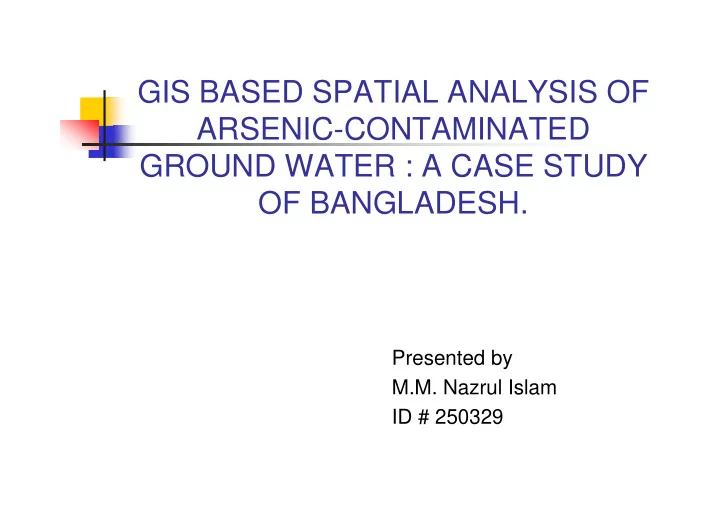

GIS BASED SPATIAL ANALYSIS OF ARSENIC-CONTAMINATED GROUND WATER : A CASE STUDY OF BANGLADESH. Presented by M.M. Nazrul Islam ID # 250329
Outline GIS Spatial Analysis Arsenic and its Effect Arsenic in Bangladesh Adopted GIS Based Approach Conclusion
GIS GIS is a collection of computer hardware , software , and geographic data for capturing, managing, analyzing, and displaying all forms of geographically referenced information.
Spatial Analysis Spatial analysis refers to the formal techniques used in various fields of research which study entities using their topological, geometric, or geographic properties. Spatial analysis provides the quantitative tools that have formed the bases for modern quantitative analysis requiring the analysis of spatially-separated phenomena.
Arsenic and Its Effect Arsenic is a chemical element that has the symbol As and atomic number 33 . It is considered as toxic in ground water.
Arsenic and Its Effect Arsenic is a slow killer . It can take a decade or more of drinking poisoned water before the physical symptoms emerge. Arsenicosis , a disease born by drinking arsenic contaminated water which can lead to a very painful death. Arsenic in ground water used for irrigation may also have affect on agriculture and food chain . No medicine available for chronic arsenic toxicity.
Arsenic in Bangladesh “Bangladesh has become an experimental station of western countries.” Dipankar Chakraborti (Local scientist and activist)
Arsenic in Bangladesh Total Population of Bangladesh : 120 million WHO arsenic drinking water standard : 0.01 ppm Maximum permissible limit of arsenic in drinking water of : 0.05 ppm Bangladesh Number of districts surveyed for arsenic contamination : 64 Number of districts having arsenic above maximum : 59 permissible limit Population at risk of the affected districts : 75 million Potentially exposed population : 24 million Number of patients suffering from arsenicosis : 7,600 Total number of tubewells in Bangladesh : 4 million Total number of affected tubewells : 1.12 million Source: BBS, Dhaka Community Hospital, NIPSOM, DPHE.
GIS Based Approach Adopted
GIS Based Approach Adopted
GIS Based Approach Adopted
GIS Based Approach Adopted
GIS Based Approach Adopted
GIS Based Approach Adopted
Conclusion The capabilities of GIS enhanced to depict the real scenario of Arsenic Problem in Bangladesh. GIS was used to organise, analyse, and display the Arsenic contamination and potential hazards. The analysis indicates large spatial variability in arsenic concentration. Greatest proportion of high arsenic wells are found in south-east of Bangladesh. Low overall concentration are found in northern Bangladesh. With the increase of depth arsenic concentration become less.
Conclusion A comprehensive information management approach must be adopted to centralize and organize the vast volumes of data with the knowledge of GIS. GIS can play a significant role by providing a long term management of water resources, farmland etc. GIS can be used to estimate the spatial distribution of arsenicosis patients and those are at risk. Subsurface based spatial analysis of As conc. can contribute in building cause-and-effect relationship.
? & THANKS
Recommend
More recommend